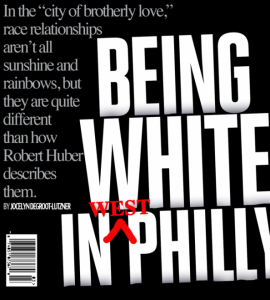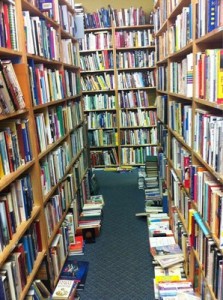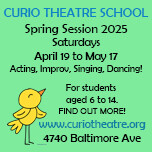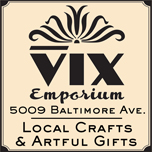[Editor’s Note: This month’s Philadelphia Magazine story, “Being White in Philly,” has been widely criticized in the city. West Philadelphia native Jocelyn Degroot-Lutzner, 22, grew up on 49th Street. She has her own thoughts about growing up in a multiracial community. This was originally posted on her company’s website IdiomsFashion.com. She gave us permission to re-post it here.]
As a 09’ graduate of Central High School, “Temple’s biggest district feeder,” I can only hope that my shock towards Robert Huber’s recent article for Philadelphia Magazine reciprocated similar feelings from my fellow Central grads (most of whom are probably neighbors of his son). As I sat reading the article on my lunch break at my New York City internship for an online magazine, I couldn’t help but lose my appetite as I felt my face grow red. His sweeping generalizations, seemingly one-sided research and the description of the “dance” he does at Wawa made me clench my fists in pain.
 I am a 22-year-old, white, female, Jewish, middle class, West Philadelphia native. I grew up in an area once referred to as West Philadelphia, but may only be known to you now as its re-branded name of Cedar Park or University City. My mother has occupied the same house in West Philly for over 30 years. Both of my parents work from home in their third floor offices.
I am a 22-year-old, white, female, Jewish, middle class, West Philadelphia native. I grew up in an area once referred to as West Philadelphia, but may only be known to you now as its re-branded name of Cedar Park or University City. My mother has occupied the same house in West Philly for over 30 years. Both of my parents work from home in their third floor offices.
During an interview I once had with the president of Starr Restaurants for a job as a hostess, I remember telling him that I grew up in West Philadelphia. He questioned whether my parents were hippies, I responded “no.” I never questioned as to why my parents choose to raise my younger brother and I in our neighborhood. Why would I question something that was normal to me?
I attended a few different public schools as well as one private school: Wilson School for Montessori and kindergarten; Powel Elementary School for 1st-4th grade; Girard Academic Music Program for 5th grade; Sadie Tanner Mossell Alexander University of Pennsylvania Partnership School for 6th-8th grade; Friends Select School for 9th; and Central High School for 10th-graduation.
I grew up with block parties, attended the University City Swim Club in the summer and worked at various jobs in my neighborhood. I taught swimming at the West Philly YMCA, sold movie tickets at the movie theater formerly known as The Bridge, sold overpriced fashions to Penn students at the West Philadelphia Urban Outfitters, and then sold those same Penn students drinks and Ethiopian food at Gojjo’s Ethiopian Restaurant back on Baltimore Ave.
Has race been a part of my life? Yes, without a doubt! Walking around West Philly I’ve been called every moniker for “white girl” that you could (or couldn’t) think of: Snow Bunny, White Chocolate and Britney Spears to name a few. I have also ventured downtown and been inappropriately hit on by white men older than my father. What did I learn from those experiences? Definitely not that one man is more respectful to young women than any other.
I remember leaving my first day of work at Urban Outfitters, we stood at the front door and emptied our pockets and personal bags as the managers checked us for any missing Urban Outfitters merchandise. While checking we were told whom we should be keeping an eye on for stealing. Race was never stated outright, was it inferred? Definitely. What was stated outright was that we should not forget to keep an eye on the well-to-do looking Penn students; they had a long history of being petty thieves at Urban Outfitters, even with daddy and mommy’s money in their wallets.
I grew up on 49th street and have a long relationship with University of Pennsylvania students. In 4th grade I had a “Penn Pal”, very literally. We exchanged letters and toured the university at the end of our school year. I attended a University of Pennsylvania Partnership public elementary school, not as big of a relationship with Penn as you might think. I’ve sold them movie ticket after movie ticket, drink after drink and watched them get caught stealing at my prior job.
I would say, overall, we have a somewhat tension fueled relationship and I say this even knowing a handful of friends that currently attend the university. Once I had a discussion with Angela Leonardo, a close childhood friend who will be graduating from Penn this May, she was reminiscing on her freshmen orientation,
I was in the tour group and near the end one of the kids asked if it was true that you shouldn’t ever go past 42nd street, and the tour guide was like, yeah I’m not sure…I haven’t ever been out there, I think it’s probably best not to… people have definitely been confused over the years when I tell them I grew up at 49th street. It was also impossible to get most of my friends to come over for dinner or hangouts.
My mother remembers twenty years ago when she was getting her masters from The Wharton School, the school’s car service would drop her off a block away from our house, refusing to go past 48th street. They also sent her a letter, suggesting she should not live past 46th street.
Has race been a part of my life? Again, I say yes! As an 11th grader I participated in Operation Understanding, it was a life changing experience for Philadelphian African American and Jewish 11th graders to learn “each others histories and cultures to effectively lead the communities of Philadelphia and beyond to a greater understanding of diversity and acceptance.” We traveled to Senegal and Israel and exchanged experiences that challenged each of us to see differently. Race was discussed daily, if not hourly.
I want to quickly discuss drugs, since it seemed to be such an important factor of Huber’s article. As a white person, more often than not I was the minority in my various schools. Drugs did not become an evident part of my classmate’s lives until I attended private school as a high school freshmen. Suddenly, people where being expelled for selling drugs or doing them on school grounds. Besides my current university, the private school I attended as a 9th grader, had the largest proportion of white students compared to other race and ethnicities and the white students were the ones doing drugs.
If I had one hope for the day I choose to begin to raise a family, it is that my children are blessed to have such a well-rounded experience of their community and our world. Hopefully it can be similar to the one I feel so lucky to have grown up in. I hope they get to experience sledding on trashcan lids in Clark Park, eating chicken patties at Brown Sugar on 52nd street, samosa’s at International Food & Spices, pretending to be models at the Kingsessing Recreation Center’s free after school programs, teaching 3-year-olds to swim at the West Philly YMCA, fighting for Philadelphia public school students at the Philadelphia Student Union office on 50th and Baltimore, and making friends that are Black, White, Asian, Hispanic (etc.). I don’t want to raise my children “color-blind” – they would miss so many beautiful things.






Recent Comments